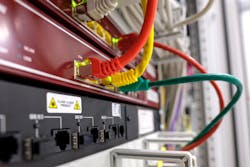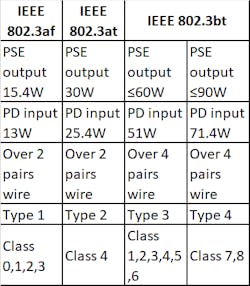Why it’s more important than ever to get authentic, interoperable PoE
By GlenNiece Kutsch, Transition Networks -- Power over Ethernet (PoE) has long been used in enterprise communications networks due to its ease of installation and convenience for powering IP devices. But PoE has also moved into many other applications, such as wireless networks, building access and control, lighting, and intelligent transportation applications.
Thanks to the latest higher power IEEE 802.3bt PoE standard, as well as the increasing number of IoT devices being deployed worldwide, use cases for PoE will continue to grow in unexpected ways. For instance, PoE is expected to play a key role in 5G networks.
With 5G poised to change nearly everything about the way we live and work, exciting new applications will be enabled, such as autonomous vehicles, telehealth, smart cities, AI-enabled robots and other industrial IoT functions. As 5G networks roll out and more concentrated coverage is needed to enable these new use cases, PoE can provide the power needed by the additional microcells.
But there are multiple ways of delivering power under the PoE name, some standardized and some not standardized, which makes it difficult to distinguish between options for powering these new network applications. If the wrong PoE solution is selected, there may be interoperability issues, a problem that only grows as more new PoE enabled devices are connected.
Issues with Non-Standardized PoE
IEEE standards for PoE devices were developed so that safe and proper communication between the power sourcing equipment (PSE) and the powered device (PD) can be achieved. However, some vendors offer PoE devices that use proprietary methods, either because they rushed to develop a particular PoE device before the industry standard was ratified, or perhaps because they want to encourage customers to use only their PoE devices.
Standardized PoE systems are backward compatible with previous PoE standards, so when a new PD is connected to a PoE network there is a handshake negotiation that takes place with the PSE to determine how much power is supported by the device. This handshake negotiation consists of four steps - detection, classification, startup, and normal operation and protection.
Detection ensures that a PSE does not send power to a data-only device, and classification is a power negotiation step that ensures a powered device is not blasted with more power than it is capable of receiving.
However, when devices in the market don’t follow industry standards for PoE, safety issues may result. This is because non-standard PoE implementation may bypass the handshake negotiation that is incorporated into the standards and essentially force power to the PD, which can result in too much power being sent and possibly damage to equipment on the network.
Compatibility is also an issue when working with non-standard PoE devices. Users may try to mix and match standardized PoE devices with non-standard devices and often find they may not be interoperable.
Not only is this frustrating for the user, but it can also be frustrating for vendors who follow IEEE standards when the customer asks why a certain PSE cannot power their PD. Alternatively, the PSE may be able to power the PD, but it might not consistently provide the appropriate power level, resulting in intermittent power issues.
Take for example PoE lighting. If a power source that doesn’t follow IEEE standards is connected to a PoE powered light that does follow standards, the light may turn on, but the level of light may fade or turn off because sufficient power is not available to maintain the light at full brightness.
IEEE 802.3bt Standard Enabling Higher Power Use Cases
The IEEE 802.3bt (PoE++) standard has enabled power sourcing devices to safely send up to 90W of PoE by sending power on all four pairs of wire in an Ethernet cable. This newest standard triples the previous 30-watt power level that can be provided from the earlier 802.3at standard.
The chart below shows the power allowed by each of the PoE standards, the number of pairs of wire power is transmitted over, as well as the type and class. All of this has been carefully outlined via the IEEE standards in order to safely and consistently allow PoE to be transmitted and received between network devices.
PoE++ is a great new option for higher power applications such as 360-degree surveillance cameras, pan–tilt–zoom (PTZ) cameras, PoE lighting, digital signage, or even IP turrets used on stock trading floors. And when it comes to 5G, PoE++ is key to enabling the exciting use cases discussed earlier.
5G networks will operate at higher frequencies, and these higher frequencies can transmit more data and faster - but the signals don’t travel as far and can’t get through walls, windows, and other hard surfaces as easily. Therefore, there will be a need for more small cell sites (outdoors on walls, light poles, etc.) that are located closer to each other.
It’s also more likely that many buildings will have their own 5G cell sites to ensure service inside the building. Standardized PoE++ devices can safely and cost-effectively provide the increased power needed for all of these cell sites, with the added benefits of ease of installation and flexibility.
Choosing the Right PoE Device
While the 60-90W IEEE 802.3bt standard is an important update for use cases that require higher amounts of power, traditional PoE, PoE+, and some non-standard methods may still be suitable options for those applications that have lower power requirements.
Considerations for safety and compatibility are key when selecting a PoE device, especially as power needs increase in those devices leveraging PoE++.
Although non-standard PSE devices can in some cases adequately power PDs, implementing PoE using equipment that follows IEEE standards is always ideal for interoperability and safety.
When deciding whether to deploy a standardized or non-standardized device, there may be a temptation to buy a non-standard PoE device because of the price point or because there is other non-standardized equipment already installed in the network.
Remember that, in the long run, this option could end up costing more due to safety issues or due to incompatibility with standardized equipment.
GlenNiece Kutsch is Senior Product Manager with Transition Networks.

